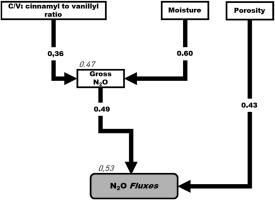Soil Biology and Biochemistry ( IF 9.8 ) Pub Date : 2023-12-09 , DOI: 10.1016/j.soilbio.2023.109274 A. Jerray , C. Rumpel , X. Le Roux , R.A.S. Massad , A. Chabbi

|
Understanding the relationship between soil organic carbon (SOC) storage and nitrous oxide (N2O) fluxes is crucial for sustainable land management. In this study, we examined this relationship in different cropping systems, including annual cropping systems with a legacy of varying durations (3 versus 6 years) of grasslands and continuous grassland. The aim was to investigate (1) the effect of contrasting management practices on SOC storage and N2O emissions under field conditions and (2) to elucidate the drivers of N2O emissions under controlled conditions. Our findings showed that despite the influence of management practices on SOC stocks, no trade-off was observed between SOC storage at two different depths (10 and 30 cm) and N2O emissions. Furthermore, we found that SOC chemical signature, soil physical characteristics, and denitrifier activity, rather than SOC content and denitrifier abundances, were the primary factors determining N2O emission potential. It is interesting to note that although functional gene abundances were related to denitrifier activities, they did not show a direct correlation with N2O emissions. This suggests that environmental factors and microbial activity play a more substantial role in determining N2O emissions than denitrifier abundances. The inclusion of temporary grassland in a crop rotation had a positive impact on SOC stocks, either by improving or maintaining their levels. However, as a trade-off the introduction of temporary grassland also led to higher N2O emissions. These increased emissions were not directly associated with the amount of SOC stored in soil but rather with changes in soil physical and chemical conditions.
Our research emphasizes the importance of understanding the complex relationships among soil characteristics, management techniques, and N2O emissions to develop practical mitigation plans for building more sustainable agricultural systems.
中文翻译:

农田和草地管理系统的 N2O 排放量取决于土壤有机质质量和土壤物理参数,而不是碳储量和反硝化剂丰度
了解土壤有机碳 (SOC) 储存与一氧化二氮 (N 2 O) 通量之间的关系对于可持续土地管理至关重要。在这项研究中,我们研究了不同耕作制度中的这种关系,包括具有不同持续时间(3年与6年)的草地和连续草地遗产的一年生作物制度。目的是调查 (1) 现场条件下对比管理实践对 SOC 储存和 N 2 O 排放的影响,以及 (2) 阐明受控条件下 N 2 O 排放的驱动因素。我们的研究结果表明,尽管管理实践对 SOC 储量有影响,但在两个不同深度(10 和 30 cm)的 SOC 存储与 N 2 O 排放之间没有观察到权衡。此外,我们发现SOC化学特征、土壤物理特征和反硝化菌活性,而不是SOC含量和反硝化菌丰度,是决定N 2 O排放潜力的主要因素。有趣的是,虽然功能基因丰度与反硝化菌活性相关,但它们并未表现出与N 2 O排放量的直接相关性。这表明环境因素和微生物活动在决定 N 2 O 排放方面比反硝化菌丰度发挥着更重要的作用。将临时草地纳入轮作对有机碳储量产生了积极影响,无论是提高还是维持其水平。然而,作为一种权衡,引入临时草地也导致了更高的 N 2 O 排放。这些增加的排放量与土壤中储存的 SOC 量没有直接关系,而是与土壤物理和化学条件的变化有关。
我们的研究强调了解土壤特性、管理技术和 N 2 O 排放之间的复杂关系的重要性,以制定切实可行的缓解计划来建设更可持续的农业系统。






































 京公网安备 11010802027423号
京公网安备 11010802027423号